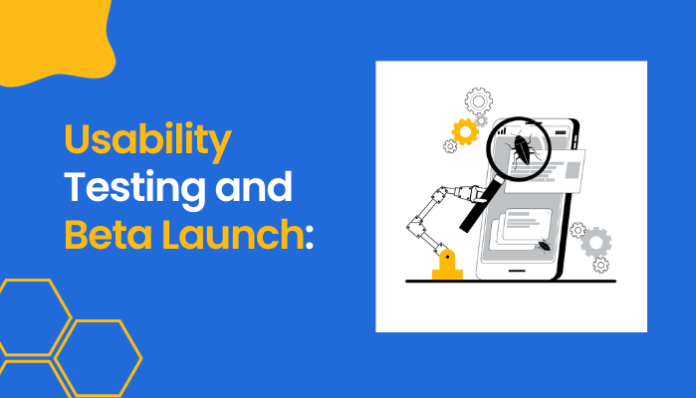When it comes to app development, usability testing, and pre-launch testing aren’t just industry jargon—they are the DNA of successful digital experiences. These practices are data-driven, and they wield significant influence over an app’s journey.
Usability testing, integral to app development, involves evaluating an app’s user-friendliness and functionality. According to the User Experience Professionals Association (UXPA), 88% of users won’t return to an app after a poor user experience, highlighting the vital role of usability testing—pre-launch testing, which includes usability testing, bridge development, and launch.
Industry reports note that 44% of users delete an app if it crashes, emphasizing the importance of pre-launch testing in delivering a seamless user experience. Further in this blog, we’ll explore usability testing and beta launch, where data informs decisions and excellence is the goal. By the end, you’ll have the insights and strategies to ensure your app’s success in a competitive market.
Usability Testing Vs Beta Launch: The Difference
Purpose
- Usability Testing: Usability testing is conducted to evaluate the user-friendliness and effectiveness of a product’s user interface (UI) and overall user experience (UX). It aims to identify usability issues, gather feedback from users, and make improvements before the product is released to a wider audience.
- Beta Launch: A beta launch, on the other hand, is a pre-release phase of a product where a select group of users (beta testers) is given access to the product to use it in real-world conditions. The primary goal of a beta launch is to identify and fix bugs, gather performance data, and gather user feedback on the overall functionality of the product.
Timing
- Usability Testing: Usability testing typically occurs early in the development process, often during the design and development phases. It helps ensure that the product’s user interface and user experience are intuitive and user-friendly before a larger audience interacts with it.
- Beta Launch: A beta launch occurs later in the development process, typically after the product has undergone initial internal testing and bug fixing. It serves as a way to test the product in a real-world environment and gather feedback before the official release.
Participants
- Usability Testing: Usability testing involves a small group of carefully selected users who represent the target audience for the product. These users perform specific tasks and provide feedback on their experience.
- Beta Launch: Beta testers can be a broader group of users who may include early adopters, existing customers, or a mix of different user segments. They may not be as carefully selected as usability test participants.
Benefits of Usability Testing
● Early Detection of Issues
By conducting usability testing early in the development phase, you can catch potential issues before they become costly to fix. This proactive approach saves time and resources, ensuring your app is polished and user-friendly when it’s time for beta launch.
● Improved User Satisfaction
Usability testing helps you understand what your users want and expect from your app. This knowledge allows you to make necessary adjustments, resulting in higher user satisfaction. Happy users are more likely to engage with your app and recommend it to others.
● Competitive Advantage
In today’s competitive app market, a well-designed and user-friendly interface can set you apart. Usability testing gives you an edge by ensuring your app meets or exceeds user expectations.
Pre-Launch Testing: The Beta Phase
After rigorous usability testing throughout the development process, it’s time for the pre-launch testing, often referred to as the beta phase. This is when you release your app to a select group of users for real-world testing. Here’s why this step is crucial:
● Real-World Testing
No amount of in-house testing can replicate the diversity of real-world user experiences. Beta testers provide feedback based on their actual usage, helping you uncover issues that might have been missed during development.
● Refinement
During the beta phase, you have the opportunity to refine your app based on user feedback. This iterative process can lead to significant improvements, making your app even more user-friendly.
● Building Hype
Inviting users to be a part of your app’s journey can generate excitement and anticipation. This can be especially beneficial if your app is designed for a specific niche or has unique features that you want to showcase.
Best Practices for Success
To ensure your app’s success through usability testing and beta launch, follow these best practices:
● Define Clear Goals
Before starting usability testing and beta launch, it is imperative to establish crystal-clear goals and objectives. By precisely outlining what you aim to achieve through testing, you provide a guiding framework for the entire process. These objectives serve as a roadmap for creating meaningful test scenarios and ensure that your efforts remain focused on your app’s core purpose and user experience.
● Select a Diverse Group of Testers
When it comes to beta testing, diversity is key. It’s not just about gathering a bunch of testers; it’s about assembling a group that accurately represents your target audience’s demographic, geographic, and psychographic diversity.
By doing so, you gain access to a rich tapestry of perspectives, ensuring that your app caters to a broad spectrum of users. This diversity helps unearth insights and feedback that you might not have otherwise considered.
● Collect Comprehensive Data
It is crucial to gather a comprehensive range of data throughout the usability testing and beta phase. This should encompass both quantitative metrics and qualitative insights. Quantitative data, such as click-through rates, loading times, and error frequencies, allows you to measure user behavior objectively.
On the other hand, qualitative data obtained through surveys, interviews, and open-ended questions provides the “why” behind user actions. This multifaceted approach to data collection enables you to identify trends, pinpoint specific issues, and make informed decisions regarding improvements.
● Be Agile
Usability testing and beta launch represent iterative processes. Embrace the feedback you receive as a dynamic force that drives progress. Agile development methodologies are particularly effective in this context, allowing you to adapt swiftly to changing circumstances and user needs. Agile development ensures that your team can respond promptly to issues and opportunities, continually refining the user experience to meet evolving expectations.
● Communicate with Testers
Keeping communication channels open with your testers is a vital component of success. Actively encourage testers to report issues and provide feedback regularly throughout the testing phases.
Their insights are invaluable and can lead to crucial refinements in your app’s design and functionality. By acknowledging their contributions and showing that you value their input, you foster a sense of partnership and investment in your testers, enhancing their commitment to your app’s success.
● Plan for Post-Launch Updates
Even after the official launch of your app, the journey is far from over. A forward-thinking approach involves planning for post-launch updates. These updates should be driven by user feedback and an awareness of evolving industry trends.
Continuously gathering user insights and monitoring app performance post-launch allows you to stay competitive and maintain a user-friendly interface. By demonstrating a commitment to ongoing improvement, you not only retain existing users but also attract new ones who appreciate your responsiveness to their needs.
Final Words
Incorporating usability testing throughout app development and embracing the power of pre-launch testing is crucial in today’s competitive app market. By focusing on user satisfaction and continually refining your app, you increase the chances of achieving your goals and standing out from the crowd. Remember, the success of your app is not just about its features but how well it serves its users.














